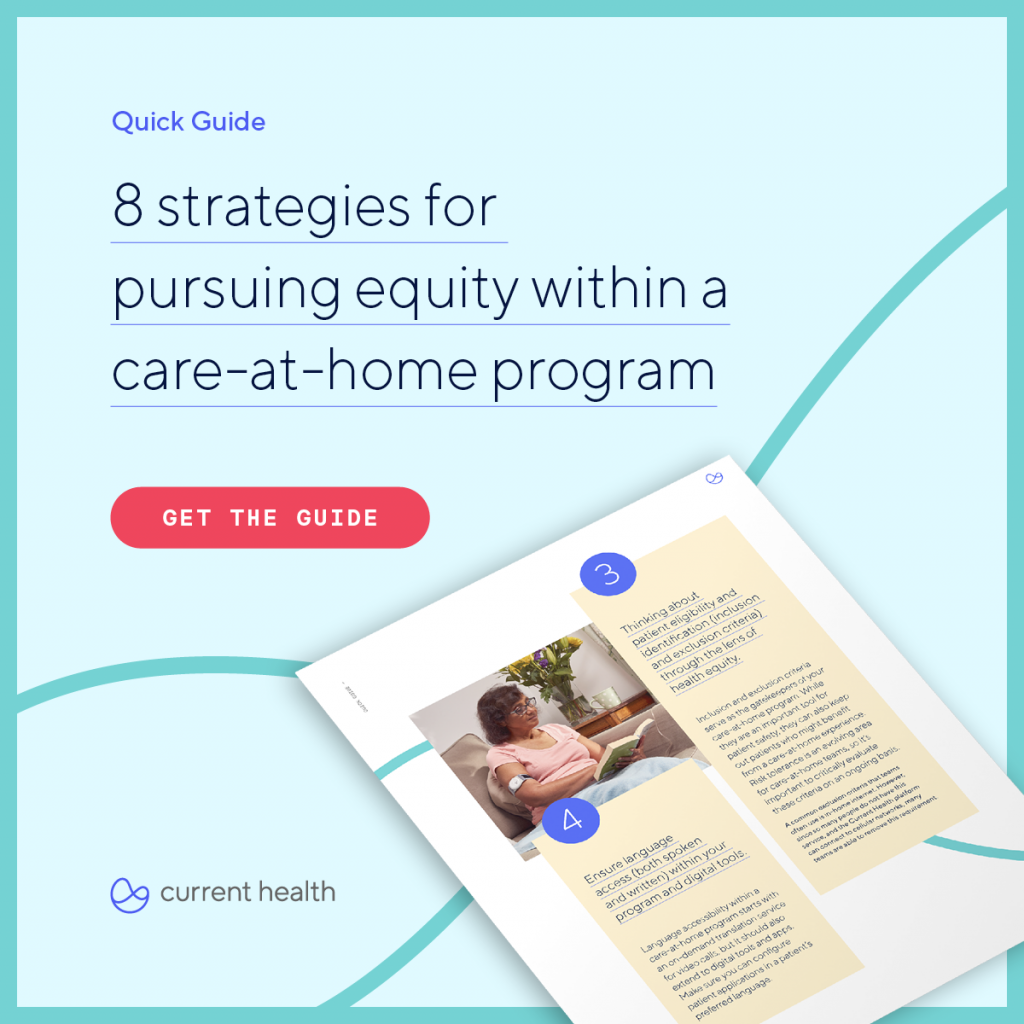How Health First makes Hospital at Home available to everyone
Within Hospital at Home programs, patients often say they feel like they are the only patient that their providers are caring for. This highly personalized care experience does not need to limited only to well-resourced patients. At Health First, a continuous commitment to health equity keeps their team ensuring the best possible care is made available to the most vulnerable patients.
In our webinar, Health Equity and Care at Home, Tracey Baker, Sr. Director of Clinical Operations and Implementation at Current Health interviewed Melissa Lutz, Nurse Manager about how Health First prioritizes health equity within their Hospital at Home program. In this blog, we review the highlights of that conversation.
Identifying eligible patients for Hospital at Home
An inclusive approach to inclusion criteria
When it comes to building an equitable program, patient identification and selection has a significant impact on who ends up benefiting from the care-at-home program. Within the program at Health First, which started in the Summer of 2021, the team reviews each admitted patient’s insurance and prescribed care. The coordinators then compare each patient to the inclusion and exclusion criteria to determine who is medically cleared to participate in the program.
Initially, one of their inclusion requirements was in-home internet access. However, as Lutz recalls, “It was a little bit of a gut check when we saw all of the patients that were automatically eliminated just because of the criteria feed down because they didn’t have internet access. So we started to take a closer look at that. Our goal is to reach the people who need us the most, because those are the people who are going to come back time and time again.”
Identifying barriers to health while in the home
When preparing patients in the hospital for transfer to their home, the intake nurse from the Hospital at Home team asks several questions to get a better understanding of the patient’s living situation, which they then confirm in their initial visit to the patient’s home.
Once the nurse arrives at the home to set up the technology and get the patient settled, they also assess key indicators about their environment and safety. They reconcile medications, check utilities, ensure safe access to the restroom, and evaluate the food in the home. While the Hospital at Home program can deliver food during the patient’s care, the team also connects their patients with community resources to help them get fresher, healthier foods if they need it.
Lutz explains a situation her team sees frequently:
“We have many elderly patients that are on very restricted budgets. One of our patients with heart failure told us he had food, but when we took him home, we saw he was living in a trailer with very inexpensive food that was high in sodium. So he’s continually bouncing back [to the hospital] because his sodium intake is through the roof.”
How the Hospital at Home model enables the team to discover and address SDOH
Tracking and measuring health equity
To measure health equity and put it into action, Lutz’s team partners with the transitional care team (TCT). Once patients are discharged from Hospital at Home, the TCT follows them with checkups for 30 days. The TCT also has connections within their medical groups to measure compliance with follow-up care.
“We measure our readmission rates for the hospital status side to see how we’re doing compared to the rest of our hospital. Currently we’re at 6.8% for the year, and the hospitals are at 14.7%. When patients come back to the hospital, we discuss what happened, and where we dropped the ball—not just Hospital at Home, but collectively—did we give this patient everything they needed?”
Training clinical staff to think about equity
Considerations when hiring clinical staff
As a nurse manager, patient equity is one of the criteria that Lutz considers when hiring and training her staff. At Health First, the hiring process consists of an initial interview with Lutz and other team members. Then, the candidate goes on a ride-along, where they accompany a senior nurse on one or two home visits.
This process allows the candidate to see the reality of the job, and the senior nurse gets to evaluate how the candidate handles potentially uncomfortable situations. Lutz explains, “If they’re still interested in working with us after the ride-alongs, then they have to think through and discuss scenarios with the team to demonstrate their problem-solving abilities.
“You have a ton of support in the background, but you’re typically the only person onsite, so that support isn’t immediate. We have our candidates go through some thinking scenarios, some crisis intervention thinking and generalized safety measures. We hire for fit, so we want to make sure we pick the right person.”
Building community trust
The staff at Health First is intentional about creating the context for trust and relationship-building between the patients and the nurses.
One of Lutz’s patients had been in the hospital for an extended period of time with multiple comorbidities. When they brought him home, it was unsanitary and one of Lutz’s nurses was very concerned about his living conditions. They gathered more team members, and together they cleaned the patient’s main living areas, and made sure his kitchen was a safe place to cook his meals and prepare his meds.
“He hadn’t done anything with that home since his wife passed away seven years ago via hospice within their own home. When it came to household chores, that wasn’t something that he was well-versed in. I thanked him for letting us help him—not to create shame, but just to give him the right footing and foundation to move forward.”
How the Health First team made sure one patient could be safely home for Christmas
Supporting the clinical team
Health First is intentional about taking care of their patients in an equitable way. The nurses get to connect with every one of their patients. They are humbled. They don’t feel they’re doing enough or are close to burnout. We have a very fortunate and wonderful nursing team, and they feel more empowered now as nurses to make an impact and show care and compassion to their patients than they had previously.
“Sometimes we have to take a timeout. When we come across patients, we remember the patients that need us the most. The patients that need our touch. The patients who need resources, and need to know where to go to get those resources. We can’t pretend that these people are not part of our community just because we don’t see them in a brick-and-mortar hospital.”
Educating health professionals about care at home
Some in the healthcare community view the Hospital at Home program as something only for patients who are wealthy, or not facing social determinants of health (SDOHs). But it’s for anyone in the community who needs help.
“Most patients with financial security don’t need our help. They’re doing a lot of their follow-up appointments. They have people who can get them there. So it’s the complete opposite. It’s a great coffee, book, conversation type of information when you start to open their eyes to what we’re able to accomplish within a home and how we’re going about it to think outside the box. We’re concierge care that is serving all of our community.”



![[Webinar Recording]This Way Home: Top 10 Predictions for Care at Home in 2025](https://www.currenthealth.com/wp-content/uploads/2025/01/DSG-846-JAN-WEBINAR-LINKEDIN-16_9-AD2-P2.jpg)